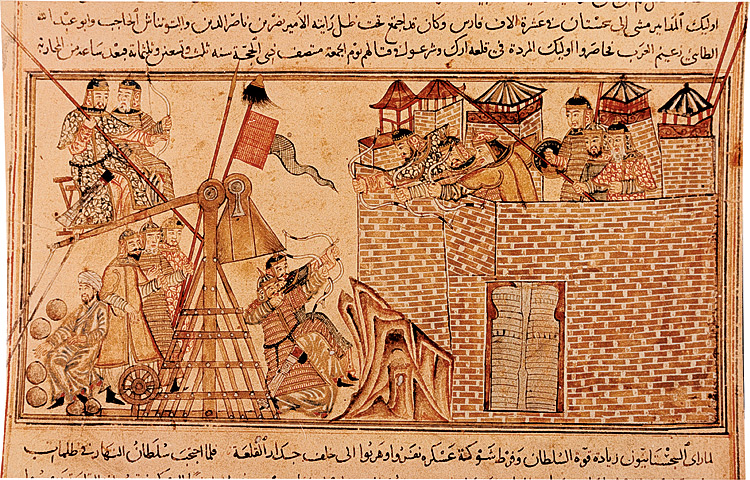Genghis Khan had the best organized and best-equipped army of his time. The numerous maneuvers and stratagems described in modern military textbooks as originating with the Mongols had been in use prior to Genghis, but he improved and formulated them as a warfare doctrine and successfully applied them on a large scale.
Organization
Before every war, Genghis Khan discussed plans at the Huraldai and so developed strategies. His spies supplied him with ample information. when he approached the protective walls of a city, temporary camps were set and supplies were gathered from the surrounding areas. His army consisted of horsemen and special engineering units. Heavy cavalry was protected by armor and carried sabers and spears while the light cavalry was armed only with bows and light spears.
Leaders of his army were promoted in accordance with their war achievements. No-one had the right to defy the leader. The kind of strict discipline did not exist in any other army. Horsemen protected only by metal helmets made up over half the army. There were also horsemen who not only were protective skins themselves but whose horses also wore them. Before each war, the silk garments the soldiers wore were watered down, as a precaution against oncoming arrows and to make it easier to extract arrows.
Battle strategies
Battles were opened by two rows of heavy cavalry and followed by three rows of light cavalry. When the first rows had delivered their initial blow, the light cavalry would advance to cover the enemy with a rain of sharp-pointed arrows shot with skillful marksmanship from a 60-kilogram bow with 250 meters range. They would then give way again to the heavy cavalry to finish off their bewildered victims. Another method they used was to saturate the tips of their arrows with petroleum oil and ignite them before shooting. The use of petroleum for burning walls has been noted as the first ever use of the substance. According to Carpini, Mongols were never ashamed to turn and flee because a flight was a strategy used to trick the enemy into chasing item, causing the enemy to divide.
Using Dogs and cats as Weapons
Genghis had surrounded the city of Tangut but could not penetrate its walls for many days. So he made a proposition to the city’s administration, telling them, “We are in need of cats and dogs. If you give them to us we will leave”. The people of the city fell for this seemingly harmless trick and gave all their cats and dogs. But not only did the Mongols did not leave, but they also dipped the animals’ tails in oil and set them on fire. The animals swallowed by flame ran back to their homes by natural instinct thus setting the entire city ablaze. Furthermore, historical writings credit Genghis Khan with being the first person to employ bacteriological warfare, evidenced by his subduing of a particularly stubborn city by throwing the carcasses of diseased animals into the city, thereby giving rise to an epidemic of a severely infectious, plague-like illness.
Psychological Attack
Of the many military techniques, Genghis devised was psychological warfare which was the most terrifying of the Mongol’s war tactics. Rumors were widespread of how he spread the lives of those who surrendered and how he killed without mercy those who did not. To spread the word, he intentionally spread a few people and gave them a chance to escape. His many methods for demoralizing the enemy have become legendary, such as making his few troops appear greater in number, having his soldiers light a large number of bonfires at night or, as he did in Hungary, mounting human-size dolls on horses.
Spies
Genghis is also believed have been the first to found a well-organized, competent and highly-networked intelligence service. He never engaged an enemy without first learning as much as he could about its military potential and the sentiments of its people. His spies, disguised as travelers and merchants, were many times the ones who threw open the gates of besieged cities. this tactic explains why Slah Muhammad of the Khwarazman Empire did not trust the four hundred merchants Genghis sent to his city.
Plano Carpini
I will tell you how well they were organized. When going into the war the Tatar king takes 100,000 soldiers. He then appoints commanding officers to lead units of 10, 100, 1000 and 10000 troops. Therefore he himself would command only 10 people. These 10 people would command only 10 soldiers and those 10 people would be responsible for another unit of 10 troops. In the end, each soldier carried out their responsibilities with magnificent efficiency and formed an organization with strict discipline.

